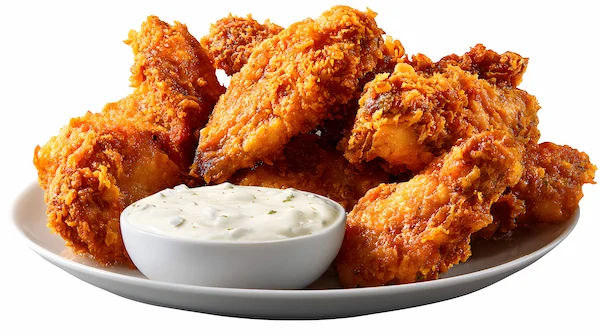Guide to Ways Manage Tempting Food Without Overeating
Struggling with overeating? Learn effective strategies to manage tempting foods without sacrificing your health goals. Discover tips for mindful eating, portion control, and building a healthier relationship with food."

Written by Dr. Mohammed Kamran
Reviewed by Dr. Dhankecha Mayank Dineshbhai MBBS
Last updated on 25th Sep, 2025

Introduction
We’ve all been there. A box of delicious pastries sits in the breakroom, a bag of crunchy chips calls your name from the pantry, or a social event features a spread of irresistible food. The intention is to have "just a bite," but before you know it, you’re feeling uncomfortably full and regretful. If this cycle sounds familiar, you're not alone. The good news is that managing tempting food doesn't require superhuman willpower or eliminating your favorite treats entirely. It’s about building a smarter, more mindful relationship with eating. This guide is designed to provide you with a practical framework to enjoy the food you love without the negative cycle of overindulgence. We will explore the psychology behind cravings, introduce powerful mindful eating techniques, and share actionable strategies for portion control that you can start using today. Let’s shift the focus from restriction to balance.
Understanding Your Appetite: The Psychology of Temptation
To manage tempting food, we must first understand why it has such a powerful pull. It’s not a lack of discipline; it’s often a complex interplay of biology, psychology, and environment.
Why We Crave: The Science of "Forbidden" Food
When you label a food as "off-limits," it instantly becomes more desirable. This is a well-documented psychological phenomenon known as reactance. Our brain rebels against the perceived threat to our freedom, making that specific food all we can think about. Furthermore, foods high in sugar, fat, and salt trigger the release of dopamine, the "feel-good" neurotransmitter, in the brain's reward center. Your brain learns that eating this food provides pleasure, creating a powerful craving loop. Understanding this can help you remove the "forbidden" label and reduce its power, a key insight for sustainable appetite control.
Emotional Hunger vs. Physical Hunger: Knowing the Difference
One of the most critical skills in managing tempting food is distinguishing between emotional and physical hunger. Emotional hunger is sudden, specific (e.g., "I need pizza NOW"), and often leads to mindless eating. It's driven by feelings like stress, boredom, or sadness. Physical hunger, on the other hand, comes on gradually, is open to various food options, and stems from a genuine physical need for energy. You feel the sensations in your stomach. Asking yourself, "Am I truly hungry, or am I feeling something else?" is a simple but transformative question that can prevent countless episodes of overeating.
Consult Top Specialists
The Mindful Eating Framework: A Powerful First Step
Mindful eating is the antidote to mindless overconsumption. It’s the practice of bringing full attention to the experience of eating and drinking, both internally and externally.
The Core Principles of Mindful Eating
This approach isn't a diet; it's a mindset. The core principles involve eating slowly without distraction, listening to physical hunger cues, engaging your senses, and acknowledging responses to food without judgment. For example, a study published in the Journal of Clinical Psychology found that mindfulness-based interventions were effective in reducing binge eating and emotional eating. By paying attention, you give your brain time to register satiety signals from your stomach, which can take up to 20 minutes.
A Simple 5-Step Mindful Eating Exercise
You can start practicing mindful eating for beginners with one meal or snack per day.
1. Check-In: Before eating, pause. Rate your hunger on a scale of 1-10.
2. Appreciate: Look at your food. Notice its colors, textures, and smells.
3. Take a Small Bite: Place a small amount in your mouth. Put your utensil down.
4. Savor: Chew slowly. Focus on the taste, texture, and temperature.
5. Pause: Between bites, take a breath. Check in with your hunger level again.
This practice naturally slows you down and enhances satisfaction, making it easier to stop when you’re full.
Practical Strategies for Portion Control
Even with mindfulness, large portions can lead to overeating. These strategies for portion control help you enjoy tempting foods in a balanced way.
Use Your Plate as a Guide: The Plate Method
Instead of eating directly from a package, always serve yourself a portion on a plate or in a bowl. Visually, divide your plate: fill half with non-starchy vegetables, a quarter with lean protein, and a quarter with carbohydrates (which can include your tempting food). This method, often recommended by nutritionists, ensures balance. If you want a slice of cake, have it, but perhaps with a side of Greek yogurt and berries to add protein and fiber, which promote satiety.
Smart Snacking: Pre-portioned Treats are Key
The danger zone for overeating is often the snack cabinet. Outsmarting cravings is easier when you plan ahead. When you buy tempting snacks, immediately divide them into single-serving portions in small bags or containers. This creates a natural stopping point. Research shows that people consume significantly more when eating from a large package than from a small one. This is a simple way to control food cravings naturally by using your environment to your advantage.
Outsmarting Cravings Before They Start
Prevention is the best medicine. By managing your hunger and hydration, you can reduce the intensity of cravings.
Don't Get Too Hungry: The Importance of Regular Meals
Letting yourself become ravenous is a surefire way to overeat tempting, high-calorie food. When blood sugar drops too low, willpower diminishes, and the body craves quick energy. Eating balanced meals and snacks every 3-4 hours helps maintain stable blood sugar levels and keeps rational decision-making in charge. This is a fundamental strategy to avoid binge eating junk food when you get home from a long day.
Hydration Hacks: Is It Thirst or Hunger?
The signals for thirst and hunger are remarkably similar and are often confused. Before reaching for a snack, drink a full glass of water and wait 15 minutes. You may find the craving disappears. Aim to drink water consistently throughout the day. Sometimes, a simple hydration hack is all you need to stop overeating at night when boredom or mild dehydration strikes.
Building a Healthy Food Environment
Your surroundings have a massive impact on your choices. Make healthy eating the default.
Kitchen Makeover: Making Healthy Choices Easy
Place healthy food options like fruits and nuts at the front of the fridge and pantry. Keep tempting foods out of immediate sight, or in harder-to-reach places. The famous phrase "out of sight, out of mind" holds true for food as well. Conversely, keep a bowl of fresh fruit on the counter. This small environmental tweak can nudge you toward a healthier choice effortlessly.
Navigating Social Situations and Dining Out
Social events are a common trigger for overeating. Plan ahead. Before going to a party, have a small, healthy snack so you don't arrive starving. When facing a buffet, survey all options first, then fill your plate once with the items you truly want. Eat mindfully, and focus on socializing rather than just the food. If your eating habits are consistently causing you distress or you suspect an underlying issue, it may be helpful to consult a doctor online with Apollo24|7 for personalized advice.
Conclusion
Managing tempting food is not about a rigid set of rules but about cultivating awareness and making intentional choices. By understanding the psychology behind your cravings, practicing mindful eating, and implementing simple tips for portion control, you can break free from the cycle of overindulgence and guilt. Remember, the goal is progress, not perfection. It's about building a peaceful and enjoyable relationship with food, where you are in control. Start small—perhaps with one mindful meal a day or by pre-portioning your snacks this week. Each positive choice reinforces a new, healthier pattern. You have the power to enjoy all foods in a way that nourishes both your body and your well-being. If you find that emotional eating is a significant challenge, consider speaking with a nutritionist or therapist for additional support. Apollo24|7 offers access to specialists who can guide you on this journey.
Consult Top Specialists
Consult Top Specialists

Dr. Harshendra Jaiswal
General Physician/ Internal Medicine Specialist
12 Years • MBBS , MD (General medicine)
Kolkata
108 DHANA DHANVANTARI Clinic, Kolkata
(25+ Patients)

Dr. Renu Saraogi
General Physician/ Internal Medicine Specialist
21 Years • MBBS, PGDFM
Bangalore
Apollo Clinic Bellandur, Bangalore
(250+ Patients)

Dr. Divyashree K
General Physician/ Internal Medicine Specialist
5 Years • MBBS
Bengaluru
Apollo Clinic, JP nagar, Bengaluru

Dr. Swagata Sircar
General Physician/ Internal Medicine Specialist
8 Years • MBBS, MD General Medicine
Kolkata
HealthYou Speciality Clinic & Diagnostics., Kolkata

Dr. Smitha Nagaraj
General Physician/ Internal Medicine Specialist
15 Years • MBBS, Diploma in Family Medicine
Bengaluru
Apollo Medical Center, Marathahalli, Bengaluru
More articles from Diet for Weight Loss
Frequently Asked Questions
1. What is the fastest way to stop a food craving?
Often, drinking a large glass of water and distracting yourself for 10-15 minutes (e.g., with a short walk or a different task) can make a craving pass. This works because it addresses potential dehydration and breaks the obsessive thought cycle.
2. I often overeat at night. How can I stop?
Overeating at night is common. Try having a balanced dinner with protein and fiber to keep you full. Establish a relaxing evening routine that doesn't revolve around food, like reading or taking a bath. If you're hungry, opt for a light, pre-portioned snack like a small bowl of yogurt instead of eating directly from a container.
3. Is it okay to eat 'junk food' sometimes?
Absolutely. A truly healthy diet includes flexibility. Labeling foods as 'good' or 'bad' creates a negative mindset. The key is portion control and frequency. Enjoy your favorite treats mindfully and in moderation as part of an overall balanced diet.
4. How can I tell if I'm an emotional eater?
Signs include eating when you're not physically hungry, eating in response to stress or boredom, eating until you're uncomfortably full, and feeling guilt or shame after eating. Keeping a food and mood journal can help identify patterns.
5. What are the best healthy snacks to curb cravings?
Choose snacks that combine protein, healthy fats, and/or fiber for lasting satisfaction. Examples include an apple with peanut butter, a handful of nuts, Greek yogurt with berries, or carrot sticks with hummus.


